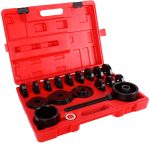In the world of mechanical engineering and maintenance, the efficient removal of bearings is crucial for ensuring smooth operations and preventing costly downtime. Manual bearing pullers have long been the trusted tool for this task, offering reliability and versatility in various industrial settings. Among the specialized tools within this domain, the outer race bearing puller stands out for its precision and effectiveness in extracting bearings from shafts and housings. In this comprehensive guide, we delve into the intricate workings of manual bearing pullers and explore the nuances of outer race bearing pullers, uncovering the techniques, applications, and benefits they offer.
Understanding Manual Bearing Pullers:
Manual bearing pullers, also known as mechanical bearing pullers, are indispensable tools used for removing bearings from shafts or housings. They come in a variety of designs, each tailored to specific bearing sizes and configurations. The fundamental principle behind their operation involves exerting force on the bearing to dislodge it from its seated position.
Key Components of Manual Bearing Puller:
- Jaws: These are the gripping components of the puller that grasp onto the bearing or its surrounding housing.
- Screw or Spindle: The mechanism responsible for applying force to pull the bearing.
- Body: The main structure of the puller that houses the jaws and spindle.
- Handles: Provide leverage for turning the spindle and exerting force.
Types of Manual Bearing Pullers:
- Two-Arm Pullers: Consist of two arms with adjustable jaws, suitable for removing bearings from shafts or housings with ample clearance.
- Three-Arm Pullers: Offer greater stability and balance compared to two-arm pullers, making them ideal for heavier bearings or applications with limited space.
- Slide Hammer Pullers: Utilize a sliding weight attached to the spindle, allowing for quick, impactful pulls to remove stubborn bearings.
Operating Manual Bearing Pullers:
- Select the appropriate puller size and configuration based on the bearing dimensions and application requirements.
- Position the jaws securely around the bearing or its housing, ensuring a firm grip without damaging the components.
- Turn the spindle clockwise using the handles to apply gradual force, loosening the bearing from its seating.
- Continue turning the spindle until the bearing is completely dislodged and can be safely removed from the shaft or housing.
Applications of Manual Bearing Pullers:
- Automotive Maintenance: Used for replacing wheel bearings, axle bearings, and transmission bearings in vehicles.
- Industrial Machinery: Essential for maintenance tasks in manufacturing plants, refineries, and power generation facilities.
- Aerospace Engineering: Employed in the assembly and disassembly of aircraft components, such as landing gear and engine bearings.
Outer Race Bearing Pullers Precision Extraction for Critical Components
Outer race bearing pullers are specialized tools designed specifically for removing the outer race of a bearing from a shaft or housing. Unlike conventional pullers, which may apply force directly to the inner race or the bearing itself, outer race bearing pullers target the outer race, minimizing the risk of damage to sensitive components.
Features of Outer Race Bearing Pullers:
- Precision Jaws: Engineered to grip securely onto the outer race without causing distortion or marring.
- Adjustable Configuration: Accommodates a wide range of bearing sizes and shapes, ensuring versatility across various applications.
- Enhanced Stability: Incorporates sturdy construction and ergonomic design to withstand high forces and maintain stability during operation.
Operating Outer Race Bearing Pullers:
- Position the jaws of the puller around the outer race of the bearing, ensuring even distribution of pressure.
- Adjust the puller configuration to match the dimensions of the bearing and the surrounding components.
- Gradually turn the spindle to apply force, exerting pressure on the outer race and easing it out of its seated position.
- Monitor the extraction process carefully, ensuring smooth and controlled removal of the outer race without causing damage to adjacent components.
Applications of Outer Race Bearing Puller:
- Precision Machinery: Critical for the maintenance of high-precision equipment in industries such as aerospace, defense, and medical manufacturing.
- Automotive Engineering: Used in the repair and replacement of bearings in engines, transmissions, and drivetrain systems.
- Heavy Equipment Maintenance: Vital for servicing bearings in construction machinery, mining equipment, and agricultural machinery.
Conclusion:
In conclusion, as industries continue to evolve and demand higher standards of performance, the reliance on advanced tools like manual bearing pullers and outer race bearing pullers will only continue to grow. By investing in quality tools and staying abreast of technological advancements, businesses can ensure smooth operations and maintain a competitive edge in today’s dynamic marketplace.
In the realm of mechanical maintenance and repair, the mastery of manual bearing pullers and outer race bearing pullers is indispensable for ensuring efficient operations and minimizing downtime. These precision tools exemplify the marriage of craftsmanship and technology, Smart Collet offering reliability, versatility, and precision in the extraction of bearings from shafts and housings.










